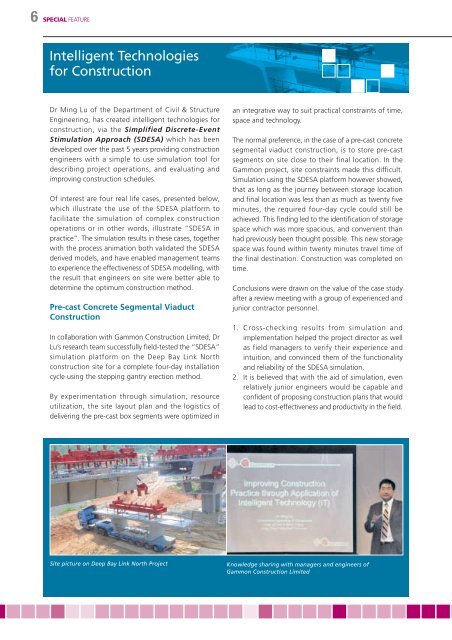Issue No. 3 (November 2006) - The Hong Kong Polytechnic University
Issue No. 3 (November 2006) - The Hong Kong Polytechnic University
Issue No. 3 (November 2006) - The Hong Kong Polytechnic University
You also want an ePaper? Increase the reach of your titles
YUMPU automatically turns print PDFs into web optimized ePapers that Google loves.
6<br />
SPECIAL FEATURE<br />
Intelligent Technologies<br />
for Construction<br />
Dr Ming Lu of the Department of Civil & Structure<br />
Engineering, has created intelligent technologies for<br />
construction, via the Simplified Discrete-Event<br />
Stimulation Approach (SDESA) which has been<br />
developed over the past 5 years providing construction<br />
engineers with a simple to use simulation tool for<br />
describing project operations, and evaluating and<br />
improving construction schedules.<br />
Of interest are four real life cases, presented below,<br />
which illustrate the use of the SDESA platform to<br />
facilitate the simulation of complex construction<br />
operations or in other words, illustrate “SDESA in<br />
practice”. <strong>The</strong> simulation results in these cases, together<br />
with the process animation both validated the SDESA<br />
derived models, and have enabled management teams<br />
to experience the effectiveness of SDESA modelling, with<br />
the result that engineers on site were better able to<br />
determine the optimum construction method.<br />
Pre-cast Concrete Segmental Viaduct<br />
Construction<br />
In collaboration with Gammon Construction Limited, Dr<br />
Lu’s research team successfully field-tested the “SDESA”<br />
simulation platform on the Deep Bay Link <strong>No</strong>rth<br />
construction site for a complete four-day installation<br />
cycle using the stepping gantry erection method.<br />
By experimentation through simulation, resource<br />
utilization, the site layout plan and the logistics of<br />
delivering the pre-cast box segments were optimized in<br />
an integrative way to suit practical constraints of time,<br />
space and technology.<br />
<strong>The</strong> normal preference, in the case of a pre-cast concrete<br />
segmental viaduct construction, is to store pre-cast<br />
segments on site close to their final location. In the<br />
Gammon project, site constraints made this difficult.<br />
Simulation using the SDESA platform however showed,<br />
that as long as the journey between storage location<br />
and final location was less than as much as twenty five<br />
minutes, the required four-day cycle could still be<br />
achieved. This finding led to the identification of storage<br />
space which was more spacious, and convenient than<br />
had previously been thought possible. This new storage<br />
space was found within twenty minutes travel time of<br />
the final destination. Construction was completed on<br />
time.<br />
Conclusions were drawn on the value of the case study<br />
after a review meeting with a group of experienced and<br />
junior contractor personnel.<br />
1. Cross-checking results from simulation and<br />
implementation helped the project director as well<br />
as field managers to verify their experience and<br />
intuition, and convinced them of the functionality<br />
and reliability of the SDESA simulation.<br />
2. It is believed that with the aid of simulation, even<br />
relatively junior engineers would be capable and<br />
confident of proposing construction plans that would<br />
lead to cost-effectiveness and productivity in the field.<br />
Site picture on Deep Bay Link <strong>No</strong>rth Project<br />
Knowledge sharing with managers and engineers of<br />
Gammon Construction Limited

















